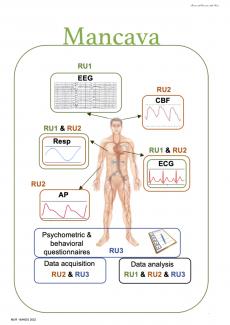
Advances in neuroimaging and system physiology are progressing many medical fields, including cardiology, vascular medicine, neurology, psychiatry and neuroscience. However, such progresses mainly rely on biomedical signal and image processing techniques applied to standalone physiological system. This attitude has led to domain-specific conclusions, neglecting between-system exchange and limiting cross-domain studies. For example, although neural disorders have notable effects on cardiovascular control and, likewise, heart diseases strongly impact on brain functioning, state-of-the-art modeling frameworks mainly address neural or cardiovascular behaviors separately.
The multidisciplinary study of functional brain-heart interplay has recently attempted to tackle these issues. This perspective has been proven successful in modeling either cerebrovascular-autonomic or cortical-autonomic interactions exclusively, while the assessment of cortical-autonomic-vascular interplay is very missing.
MANCAVA sets out fundamental methodologies for characterizing human fundamental physiological system interactions at a whole-body level, particularly focusing on the interplay among cortical brain activity, autonomic function, and cerebrovascular autoregulatory mechanisms. By investigating the complex, time-varying mechanisms underlying the multisystem dynamic interactions, novel methods linking various brain areas and reflex functions to target organs and districts such as heart and circulatory system are proposed with the clinical aim linked to the emerging topic of depression.
In this scenario, proper new mathematical tools will allow a significant leap from the current state of the art, paving the way towards a new understanding of leading comorbid contributors to global diseases such as cardiac and cerebrovascular morbidity in mood disorders.
The MANCAVA comprehensive multivariate modeling framework will be tested on datasets acquiring simultaneously electroencephalogram (EEG), electrocardiogram (ECG), cerebral blood flow (CBF), systemic arterial pressure (AP) and respiration (R). Suitable beat-to-beat series describing the variability of markers, the response of physiological control mechanisms to challenges, and the degree of coordination among different systems will also be derived from signals. Moreover, parameters describing the dynamic interactions among physiological systems will be combined with psychometric, behavioral, and imaging data according to a multimodal framework. In turn, this will provide an integration among physiological and psychological dimensions for a more holistic view on depression.
Researchers, professionals, and patients will all benefit from a comprehensive assessment of brain-mind-body interplay, leading to the new extended definition of default mode/mood network, neurovascular-evoked responses to autonomic stimuli, brain-autonomic consequences of emotional responses, and physiological substrates of depressive states.
Principal Investigator: Prof. Gaetano Valenza

